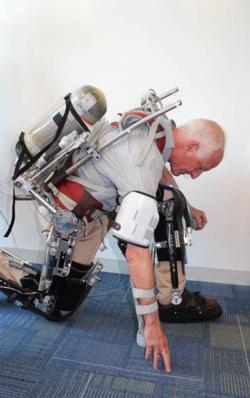Sat, Aug 24, 2013
Trains Astronauts For Reduced Mobility When Wearing A Pressurized Suit
Aurora Flight Sciences has delivered a completed Space Suit Simulator (S3) to NASA following the successful completion of a Phase II Small Business Innovative Research effort. Aurora collaborated with Professors Dava Newman and Jeffrey Hoffman of the Massachusetts Institute of Technology (MIT) Department of Aeronautics and Astronautics, as well as Professor Grant Schaffner from the University of Cincinnati, for this program.

The S3 was developed to meet NASA's research and training needs. Pressurized space suits impose high joint torques on the astronaut, reducing mobility for upper and lower body motions. Because of the highly altered mobility capabilities and metabolic cost of movement when wearing a space suit, it is necessary for suits to be worn during many aspects of astronaut training and ground-based research. Using actual space suits is problematic due to the expense, bulk, weight in Earth's gravity, and difficulty in donning/doffing.
Aurora has developed a low-profile, lightweight, space suit simulator to provide high-fidelity emulation of NASA's Extra-Vehicular Mobility Unit, the EMU. "An astronaut experiences resistance from the space suit primarily in his or her joints, such as the knees, hips, and shoulders. We have developed an exoskeleton that includes actively controlled resistive elements at each of the lower body joints," said Dr. Jessica Duda, Aurora's Principal Investigator for this project. "By using active control, we are also able to calibrate the joint torques for current or future space suits." The current EMU requires very high metabolic costs (fatigue and calories burned) due to the energy required to bend the pressurized limbs. Future suit designs will focus on reducing joint torques. The S3 provides a means of measuring the metabolic costs of various joint torque configurations to aid in developing an optimized design.
Working with MIT, Aurora tested each of the joint concepts on an anthropometric robot with instrumented joints and verified the torques provided by each of the joints. The completed S3 is adjustable for human subjects up to 95th percentile male and is expected to be used in university field trials this summer.
(Image provided by Aurora)
More News
Say Altitude Used by ATC to ascertain an aircraft's specific altitude/flight level. When the aircraft is climbing or descending, the pilot should state the indicated altitude round>[...]
Aero Linx: European Air Law Association (EALA) EALA was established in 1988 with the aim to promote the study of European air law and to provide an open forum for those with an int>[...]
From 2023 (YouTube Version): The Life, Death, Life, Death, and Life of a Glorious Warbird In 1981, business-owner Jim Tobul and his father purchased a Chance-Vought F4U Corsair. Mo>[...]
Also: USCG Retires MH-65 Dolphins, Irish Aviation Authority, NATCA Warns FAA, Diamond DA42 AD This summer, history enthusiasts will have a unique opportunity to experience World Wa>[...]
Also: WACO Kitchen Bails, French SportPlane Mfr to FL, Dynon-Advance Flight Systems, Innovation Preview Bobby Bailey, a bit of a fixture in sport aviation circles for his work with>[...]
 ANN's Daily Aero-Term (05.01.24): Say Altitude
ANN's Daily Aero-Term (05.01.24): Say Altitude ANN's Daily Aero-Linx (05.01.24)
ANN's Daily Aero-Linx (05.01.24) Classic Aero-TV: Korean War Hero Twice Reborn
Classic Aero-TV: Korean War Hero Twice Reborn Airborne 04.29.24: EAA B-25 Rides, Textron 2024, G700 Deliveries
Airborne 04.29.24: EAA B-25 Rides, Textron 2024, G700 Deliveries Airborne Affordable Flyers 05.02.24: Bobby Bailey, SPRG Report Cards, Skydive!
Airborne Affordable Flyers 05.02.24: Bobby Bailey, SPRG Report Cards, Skydive!



